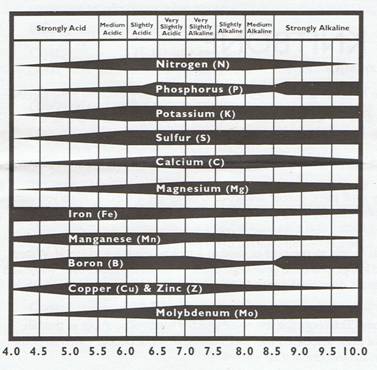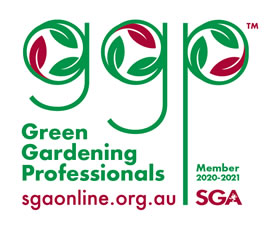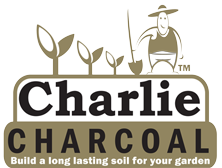| item(s), Total: $0.00 View Cart |
| Shopping cart is empty. |
Soil pH

Many gardeners are not aware of how the pH of their soil can affect the growth and health of their plants. Even what the initials ‘pH’ stand for (potential hydrogen) sounds too scientific and confusing for many people. However, you don’t need a science degree – in reality a basic understanding of the principles involved will help you out.
What pH measures is how acid or alkaline your soil is. This balance affects the plant’s ability to access and benefit from nutrients which are present in the soil. In many instances, what appear to be signs of nutrient deficiency in plants (ie. Yellowing leaves, stunted growth) are directly attributable to an incorrect pH balance.
Most plants prefer a neutral soil, which has a pH of between 6 and 7. When the pH falls below this, conditions are said to be ‘acidic’, when above they are said to be ‘alkaline’. The table below will help you see the affects of rising or falling pH on nutrient availability.
Take the element of iron for example. The thickness of the bar indicates availability, so reading off the numbers at the bottom of the chart, it is most available between the ranges of 4.0 – 6.0, and then begins to taper off slightly. By 7.5 the availability has considerably decreased.
If you rule a vertical line through the chart at around 6.5 – 7, you will notice that most of the bars representing the elements are near or at maximum thickness – meaning at optimum availability. So you can see the further off this mark – either to the acidic or alkaline sides of the scale – certain nutrients become unavailable to plants.
How pH can be tested.
Simple pH kits are available for around $30. These kits were developed by the CSIRO and last for many uses. Alternatively, at the Green Life Soil Co. we are happy to conduct a free test for you. All we need is a small amount of soil (approx. ½ a cup) taken from the top 10 – 20cms, ie. the root zone of your plants. (If we are too busy to do the test on the spot, you can leave it with us and we will let you know the results later!)
How to correct a pH imbalance.
If your soils are a little on the acidic side, adding lime (we recommend dolomite lime) at a rate of approx. 100gm/m 2 for sandy soil. (For heavier loam, 200gm/m 2, and up to 300 – 400gm/m 2 in heavy clay). It is often best to do this in 2 or 3 doses over a period of months rather than one large hit, which may be a shock to some plants.
Should your soils be alkaline, it is a little more difficult to fix the problem, but not by any means impossible. One of the fastest ways is to add sulphur, or a sulphate such as iron sulphate, at a rate of approx. 25gm/m 2 for sandy soil. (For heavier loam, 50gm/m 2, and up to 100gm/m 2 in heavy clay.) Iron sulphate can be used at approx. double the rates above, however as it will also increase salinity it should be added over a period of time and watered in well.
Often alkalinity problems can be linked to factors such as limestone soils, or even limestone or cement building structures. Sometimes problematic garden beds have a dark secret – builders rubble (cement and plaster waste) buried deep, that continue to leach lime over the years!
Adding sulphur can be a temporary fix. Adding organic matter tends to be helpful long term, particularly with things of a naturally acidic nature such as pine needles and sawdust.
To counteract alkaline soils, we also recommend Charlie Charcoal - this amazing biochar has a naturally low pH and can lower and stabilise the pH of your soil. Plus it has many other benefits to do with nutrient holding and water holding - we use it in all of our mixes @ GLSC in varying quantities, depending on the intended use of the soil.
A final word of warning! Many gardening TV shows and magazines produced in the Eastern States routinely advocate adding lime to garden soil. Remember that our soil types in the West vary greatly from those over East, so before randomly throwing handfuls about, please test your soil first to ascertain whether YOUR garden really needs it! We generally find Perth coastal suburbs are alkaline, while those in the Perth hills tend to be more acidic. However, sometimes soil has been brought in from other areas and this can have a huge impact on what your base soil readings may be. There's not just one type of "Perth soil" - so come and have a chat with us, bring in your soil sample and we can help!
Also: Adding organic matter and having a healthy soil microbial life can 'buffer' pH meaning plants can still access nutrients. Observation of how things are growing is really the best way to see whether you have a problem. Readings which may be "too high" or "too low" are totally irrelevant if you have a booming garden (and may just be attributed to a dodgy reading)!
Get Growing Today!
Come on in!
Pick up bags or bulk product bring your trailer (or use one of ours) Opening hours: 8.30 - 4.00 Monday - Saturday (closed Sunday)
Shop Online - We Deliver
24/7 convenient & secure online shopping or support your local independent retail outlet
Get Growing
We guarantee our products. Ask our friendly staff for help & advice ~ we're here to help you achieve the garden of your dreams.
























